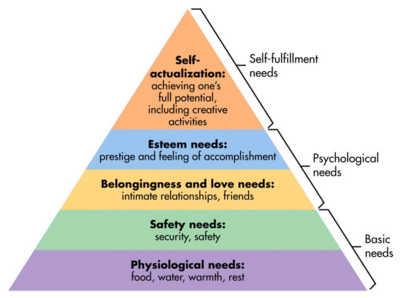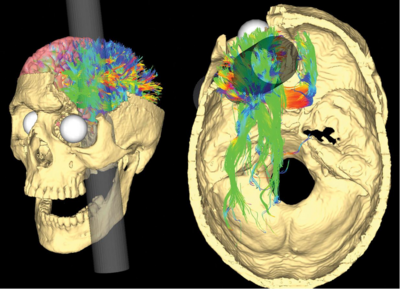The big five (OCEAN)
(→History of development) |
(→History of development) |
||
| Line 40: | Line 40: | ||
[[File:Simulated Connectivity Damage of Phineas Gage 4 vanHorn Pathways Damaged.png|400px|thumb|center|Simulated Connectivity Damage of Phineas Gage 4 vanHorn Pathways Damaged, by Van Horn JD, Irimia A, Torgerson CM, Chambers MC, Kikinis R, et al. is licensed under CC BY 2.5]] | [[File:Simulated Connectivity Damage of Phineas Gage 4 vanHorn Pathways Damaged.png|400px|thumb|center|Simulated Connectivity Damage of Phineas Gage 4 vanHorn Pathways Damaged, by Van Horn JD, Irimia A, Torgerson CM, Chambers MC, Kikinis R, et al. is licensed under CC BY 2.5]] | ||
| + | |||
| + | Phineas survived, but his personality changed greatly due to the damage to his brain. He took on different characteristics and became a different person, his friends reported. This made it clear that the physical size and individual areas of the brain make up the personality of an individual. | ||
| + | |||
| + | Another historically important point in personality psychology was Sigmund Freud's psychoanalysis and his studies of the human mind, which laid the foundation for further insights. A far more enduring influence, however, was Carl Jung's analysis that personalities can be classified as introverted and extroverted. | ||
| + | The American psychologist Abraham Maslow also drew on Freud's initial findings and based his hypothesis that personality is strongly dependent on the needs of the individual. Maslow created a diagram with the different levels of these needs: | ||
| + | *Physiological needs | ||
| + | *Safety needs | ||
| + | *Belongingness and love needs | ||
| + | *Esteem needs | ||
| + | *Self-actualization needs | ||
| + | |||
| + | [[File:maslow-diagram.png|400px|thumb|center|Maslow diagram, by https://www.simplypsychology.org/maslow.html]] | ||
== Application: == | == Application: == | ||
Revision as of 21:35, 21 February 2021
in progress
Timo Scheitinger
Contents |
Summary / abstract
The OCEAN model, also called the five factor model or big five model, is an important component of modern personality theory in psychology. The model is composed of five main characteristics:
- Openness to experience
- Conscientiousness
- Extraversion
- Agreeableness
- Neuroticism
These characteristics vary from individual to individual and change only slightly over the course of a lifetime. Nevertheless, there are influences on the personality like genes and gender. Of course the character itself affects the environment as well and have an influence on the health, working life and relationship of the individuum. The outcome of an OCEAN model based test can be used in the program or project planning phase to delegate different tasks to the employees that fit the best.
Big idea
Definition of personality
“Personality refers to individual differences in characteristic patterns of thinking, feeling and behaving.” [1] Moreover, the definition of personality in psychology is not fixed. There are several theories that attempt to define a person's personality. The OCEAN model is widely used to define traits.
History of development
As early as ancient Greece, people discussed personality and tried to explain it with models. Hippocrates tried a model with 2 opponents:
- Moist vs dry
- Hot vs cold
According to Hippocrates, these factors make up the temperament, and thus the character, of a person. Plato then came up with the idea of dividing the personality into factors, and thus his four-factor model came into being:
- Artistic
- Sensible
- Intuitive
- Reasoning
Aristotle, in turn, studied these models and came to the conclusion that the physical body of a person has a significant influence on personality. This was not seriously considered until the case of Phineas Gage. Phineas Gage, a railway worker in the 19th century, had a serious work accident while developing a new railway line. A blast misfired and a one-metre long iron rod with a diameter of 3.2 centimetres shot through his head.
Phineas survived, but his personality changed greatly due to the damage to his brain. He took on different characteristics and became a different person, his friends reported. This made it clear that the physical size and individual areas of the brain make up the personality of an individual.
Another historically important point in personality psychology was Sigmund Freud's psychoanalysis and his studies of the human mind, which laid the foundation for further insights. A far more enduring influence, however, was Carl Jung's analysis that personalities can be classified as introverted and extroverted. The American psychologist Abraham Maslow also drew on Freud's initial findings and based his hypothesis that personality is strongly dependent on the needs of the individual. Maslow created a diagram with the different levels of these needs:
- Physiological needs
- Safety needs
- Belongingness and love needs
- Esteem needs
- Self-actualization needs

Application:
Limitations:
Annotated bibliography:
- ↑ Alan E. Kazdin PhD, Encyclopedia of psychology, 2000
